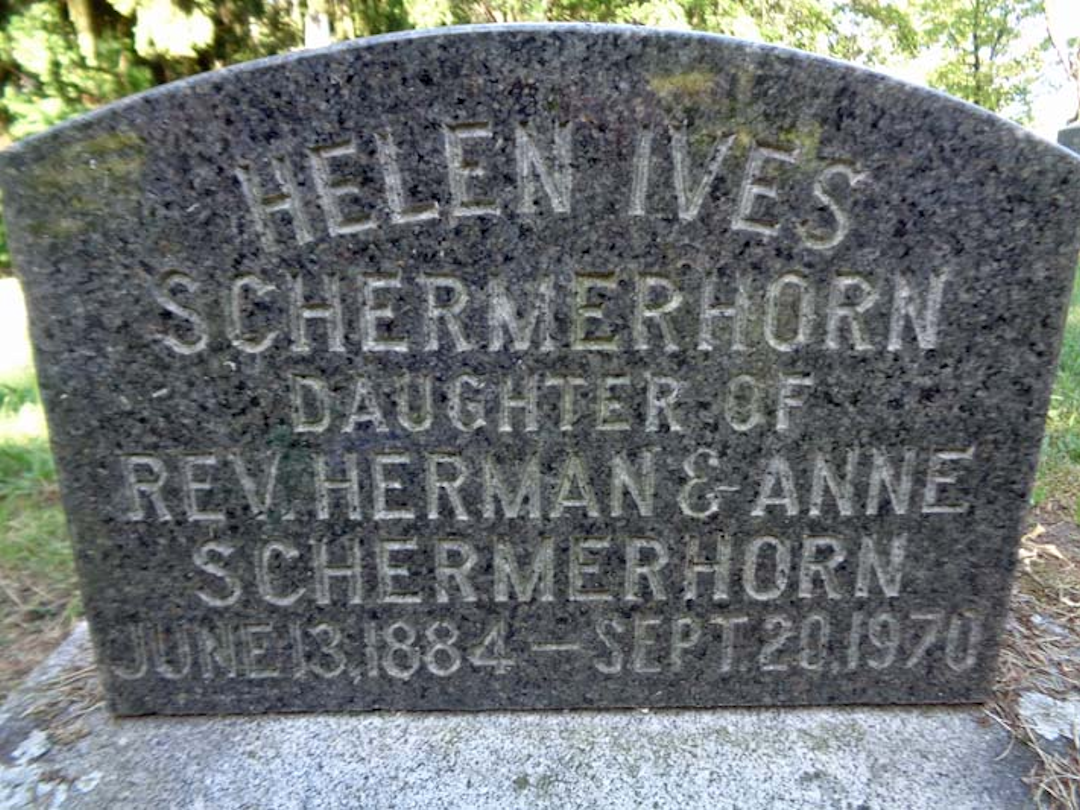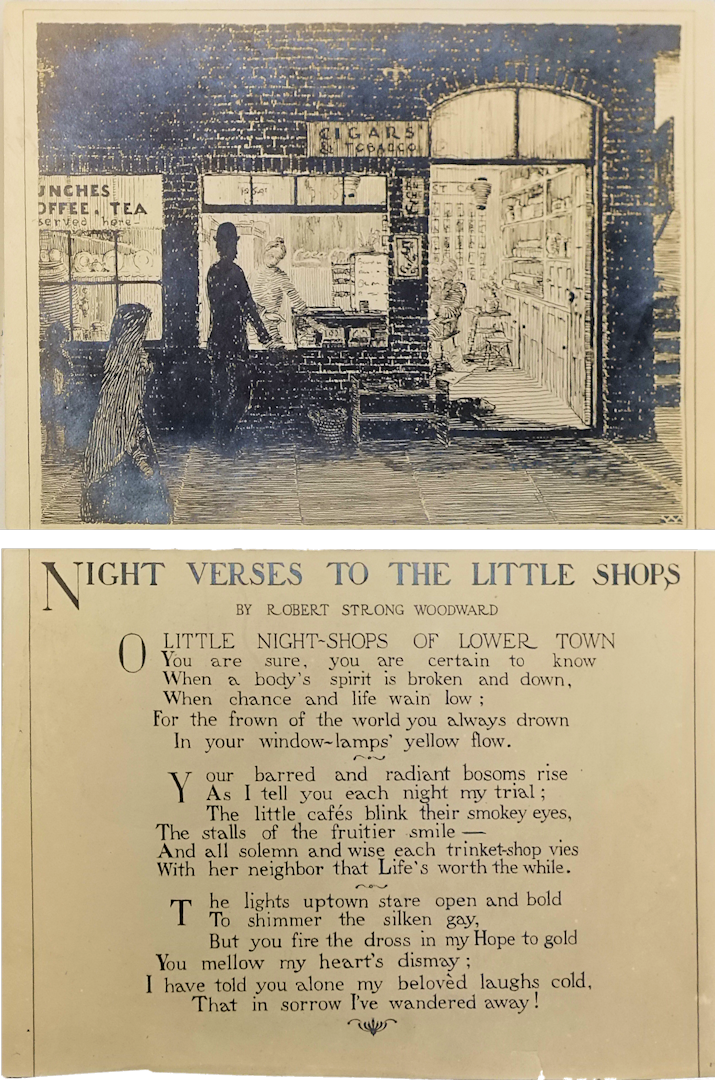Childhood Friend: Helen Ives Schermerhorn
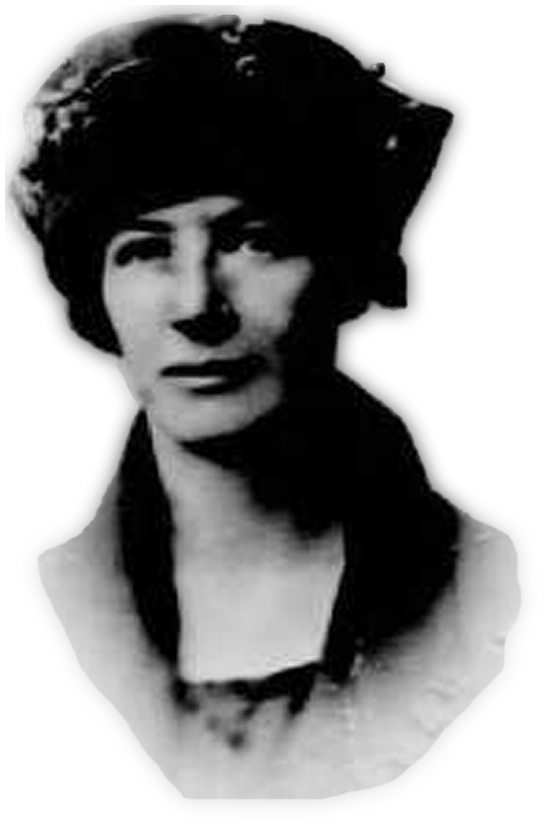
 From Helen Ives Schermerhorn
From Helen Ives Schermerhorn
passport photo, 1920
It is not clear what year RSW first met Helen, nonetheless, we do know they met at the Union Classical Institute (UCI) of Schenectady,
New York. UCI was a private elementary school program run by Union College before it became Schenectady's first high school and renamed Notts Terrace (1904). Woodward's father, Orion Leroy (O.L.), was a real
estate developer and frequently moved his family all about the country. We believe RSW was in Schenectady for at least part of his 10th grade year (1901). We do not know when he arrived or if he had been there
an entire year. RSW claims to have attended as many as 17 schools prior to Peoria which could only mean he did not spend an entire year at a number of those schools. (if he started school at age 5 and spent two
years at Bradley from the age of 16/17 on, then that is 17 schools in roughly 11 years)
Their letters begin in November of 1901 with her apologizing to him for not properly saying goodbye at the train
station because she got distracted by another acquaintance at the station heading to New York City. She ends the letter saying, "We shall miss you very much at school, and I hope that we may have the opportunity
of hearing from you some time..." suggesting he left UCI mid-year. Then in May of 1902 she writes him a thank you letter for a "May basket" he must have sent her. These are the only two letters written by her in the
collection. Woodward himself did not keep the letters he received from the numerous people he corresponded. Helen, in fact is only one of 3 people who saved their letters from RSW. Helen's letters were given to his
Cousin Florence by Helen's sister-in-law Anna after Helen's death in 1970. Florence then gathered her own papers regarding RSW, Helen's and a number of RSW's
personal items and donated them to the Smithsonian Institute where they are now held. If it not for Helen (or Florence), we would know very little about the likes,
dislikes and personal side of RSW, especially his years in Peoria, IL or his state of health and well-being in the months immediately following his tragic accident. We do not think she kept every letter but from 1902 to
as late as 1953, it seems she kept ones that had a particular interest or importance to her.
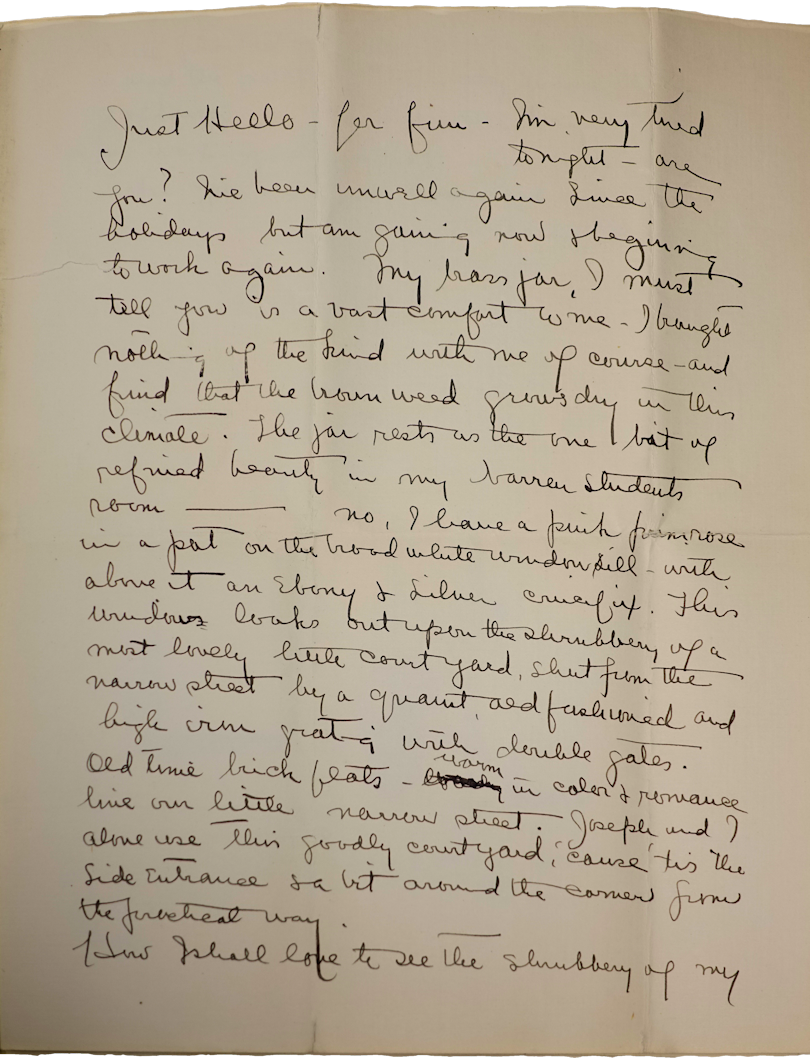
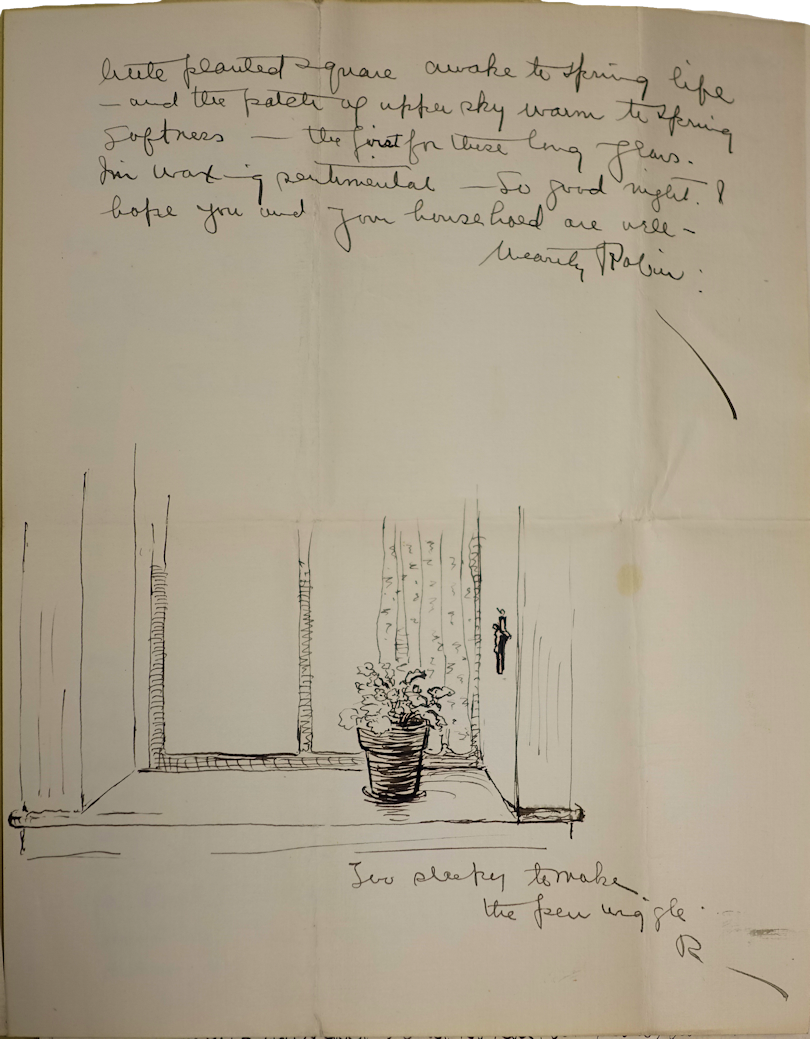
 A fall of 1910 letter to Helen, sent from Boston, describing the apartment
A fall of 1910 letter to Helen, sent from Boston, describing the apartment
he is sharing with his friend Joseph. He ends the letter with a sketch of the
window and signing off "Too sleepy to make the pen wiggle. R--"
The "Schermerhorn Letters" are extremely valuable to us here at the website. For instance, we know that RSW had always dreamed and thus intended to attend the Boston Museum of Fine Arts School despite his father's desire he follow in his footsteps and go to Leland Stanford Jr. University (now Stanford University) for engineering (most likely civil). Woodward shared with Helen more personal information than any other source we have at our disposal. Even his personal diaries were simply mere accounts of his daily activities and the weather (boy did he reference the weather in great detail, describing the sky right down to the type of clouds). He did not share many personal thoughts or sentiments. He would give Helen a serial account of his time in Peoria, IL attending the Bradley Polytechnic Institute (now Bradley University). We know a number of the classes he took and even his grades. His social life and his friends. We know what he was reading and who he really appreciated, like naturalist, Emile Zola, poet Robert Browning and playwright Henrik Ibsen. He expressed his preferences in colors and textures or skies (greys, blues and greens and skies to the north and south). Such things permit us to examine his work to see if these
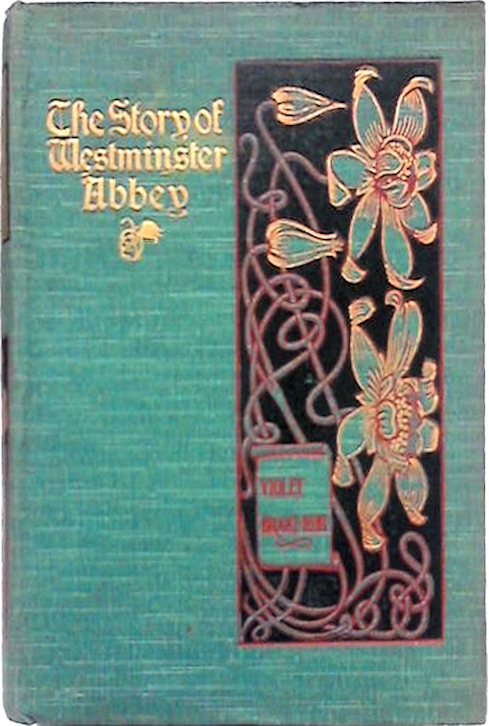
 The1904 book, "The Story of Westminster
The1904 book, "The Story of Westminster
Abbey" by Violet Brook-Hunt that RSW tells
Helen about in one of his letters was a
Christmas gift from Mrs. Bourland in Peoria. RSW
was particularly impressed with its illustrations.
matters held true into his adulthood. (There is just a handful of work with dramatic and colorful skies to the east or west. A majority of them are illuminations and not paintings!) We also learn of his passion for what he refers to as "Social Economics" and matters of broad moral and ethical questions. We know he loved salon-like discussions with his friends in the park. In a summer of 1905 letter to Helen, he tells her, "...That is our "family." The "family" as you may have guessed are all very near to each other. We talk about, religion, that is broad belief, sociology, etc, etc, and read a great deal together. We do not like parties and big picnics, as a general rule, but enjoy quiet times which we love together. We all deeply love nature, color and the poor..." Finally, from Helen's letters, we learn a great deal about his general state of well-being after his accident, his hopes for the future and his trouble in the present... we also learn how he finally makes it to BMFAS and his brief time in Boston with friend, former classmate at Bradley, Joseph Cowell.
While it appeared RSW held Helen in high esteem and expressed great affection towards
her, we are unable to determine with any certainty whether there was a romance between the two. He did proudly wear her Vassar pin on his lapel for a period. He was expected to return it but years later, after his
accident, he still had it. We simply do not know enough of the social norms and rituals of the period. In the fifties, wearing someone's pin meant you were, committed, spoken for or "going steady". In fact, wearing
anything of someone else implied a relationship. By all accounts, "dating" as it is known today has its roots in these early twentieth century years, nonetheless, there is not much more to know than this wasn't a
traditional courtship of the 1800s. We also, we do not have the benefit of seeing her side of the letters. RSW did, in fact, live with her family for a period so he could finish out the school year while his parents headed
off to O.L.'s next project in Peoria. He often addressed her as "ma chere" meaning "my dear" denoting more respect than affection. Had he used "mon cheri" meaning "my darling" maybe we would be having a different
conversation. It was, after all, a long distance relationship and so in all likelihood their relationship was more "familial" than romantic.
CLICK HERE for more on RSW's relationship with Boston
( Page will open in a new tab)
 A 1920 group picture of the National Collegiate Sorosis Sorority for which Helen was a member.
A 1920 group picture of the National Collegiate Sorosis Sorority for which Helen was a member.
You will find her in the first row, second from the right. Helen was a graduate student at Columbia University at the time.
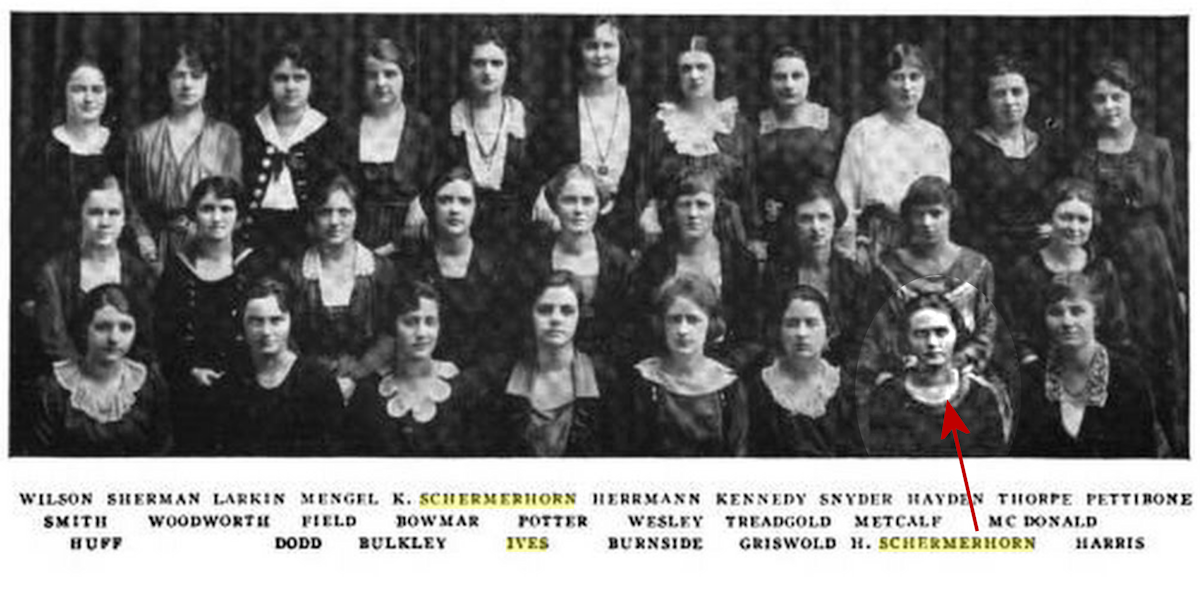
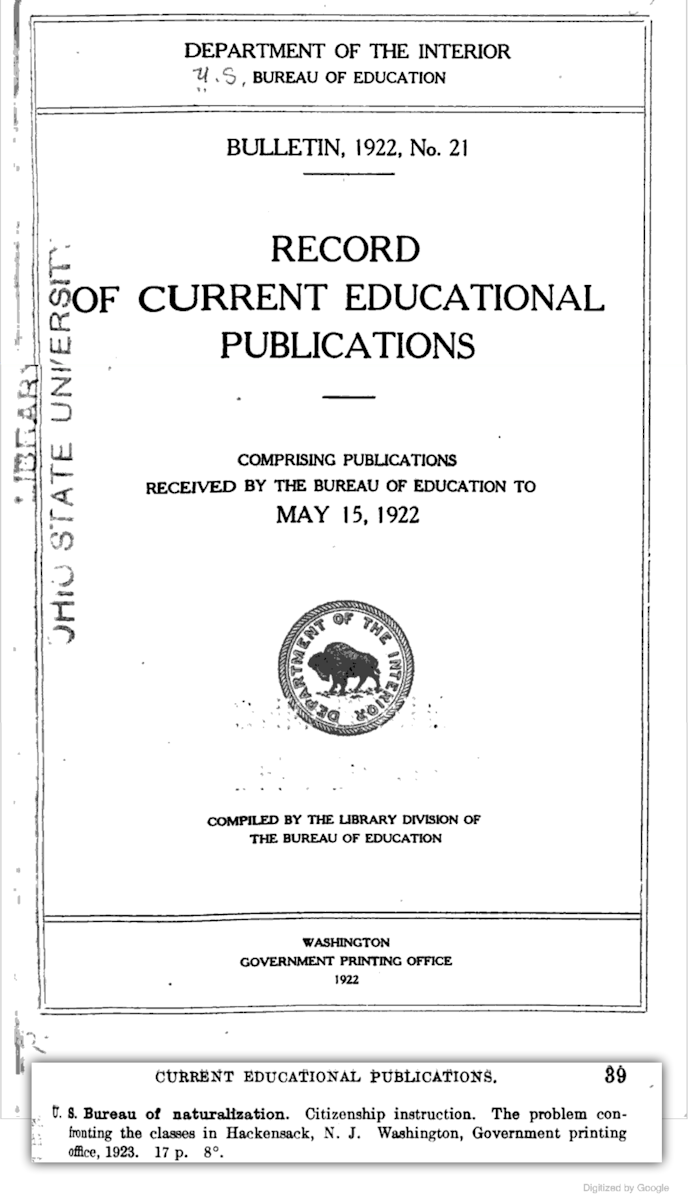
 A screen capture of the May 15, 1922
A screen capture of the May 15, 1922
issue of the Record of Current Eductational
Publications. Helen's book is found on page
89, showed on the bottom of the image.
Helen Ives Schermerhorn was born to Rev. Herman Mourus and Anne Budington Duryee Schermerhorn on June 13, 1884. She would be one year older than Woodward and lose her father, a Union College ethics professor and grandson of Judge Issac Schermerhorm (famous for carrying on a correspondence with Pres. Lincoln), at the early age of four years. It is unclear whether her mother re-married. We could not locate any records. She had a brother, Henry (b. 1887), who RSW would ask about from time to time and later married the Anna who would pass on his letters to Florence. From a family of politicians, academics and educators (her grandfather was a medical doctor and educator)... she would pave her own path of notoriety in each of those fields. Though a teacher/educator, she was herself an academic. As a Carola Woerishoffer Fellow in Social Economy and Research at Bryn Mawr College (PA) and serving as Principle of the Hackensack Night School she published a book, "Citizen instruction: The Problem confronting the classes in Hackensack," funded by the Department of Naturalization and cited as being among the "most widely held works about the United States." Still, this would not even be her first published book...
After Woodward left UCI in 1901, the school was in the midst of being transformed into Schenectady's first high school. That transition would be completed in 1904, the first year and graduating class of Notts Terrace High School. Helen was among its first class of graduates. That very same year she served as Editor-in-Chief of the book, "In memory of the Union Classical Institute of Schenectady, New York," a collection of stories and remembrances of the old school by many of its alumni. The book is offered by Amazon.com as part of their re-print program to make available books that could get lost to time. Helen then headed off to Vassar College in Poughkeepsie, NY. She would graduate in 1908 and return to Schenectady to teach at Schenectady's second high school, The Brown School until 1915 and then leave to teach at The Albany (NY) School for Girls until 1919. She would head to Columbia University's graduate school 1920 - '22. In all of the research put into Helen, we could not find what advanced degrees she received. No place we search ever referred to her as Dr. Schermerhorn. We assume, at the very least she earn her masters but what of the fellowship at Bryn Mawr and subsequent book? Was the book her doctoral thesis? Did she earn her doctorate? Helen would remain an administrator / educator for the rest of her life. We do not know how much longer she spent in Hackensack. The 1930 census has her still in New Jersey but by 1940 we find her in Providence, RI as the head of the district's night school program.
What is fascinating about Helen's career is the "night school" aspect. In Helen's time, the leading career choices for women was either secretary, librarian or teacher (nursing was still in its infancy as a profession). So her ending up a teacher is by no means a surprise but that her career was steered, we believe, by certain political influences interest us a great deal. We imagine Helen could have done just about anything she wanted but was handicapped by the mores of the time. UCI, while progressive in admitting girls even prior to compulsory education laws, limited them to only one choice of study, the Classical Languages. They were prohibited to study science or modern languages. UCI and subsequently Notts Terrace did offer a one year post-graduate course to become certified teachers. We suspect she took advantage of this, though we could not find the evidence. She was nearly a whole year older (11.5 months exactly) than RSW and yet graduated (HS) the same year as he did.
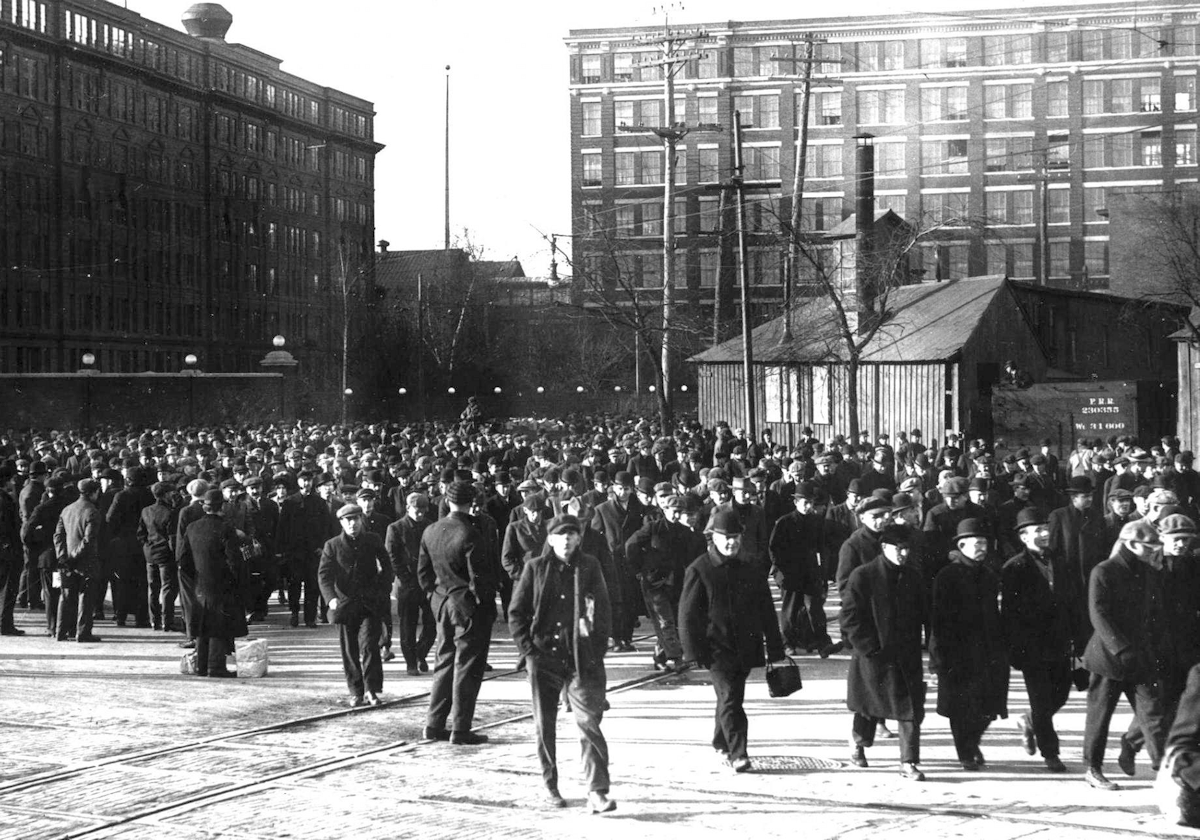
 Workers leaving General Electric, Schenectady
Workers leaving General Electric, Schenectady
Schenectady since 1880 had been just booming in industry and growth. It doubled its population each of the next three decades (pop. 1886- 14,000... 1890- 19,902... 1900, 36,682...). Much of our resource regarding Schenectady and its education system comes from a wonderful book written in 1962 by Jeanette Neisuler, The History of Education in Schenectady, 1661-62 - 1961-62 and of particular interest, the chapter (9) covering Helen's time there. In Ch. 9, Ms. Niesuler put it this way, "The bigger the city grew, the bigger grew the problems relating to the schools. The demand for space, always a primary concern, refused any longer to be put off. The city's big building boom was faintly echoed by the school system's expansion program..." Along with this boom in population, the demand for jobs was being filled more and more by-in-large with unskilled labor, "...The city was not just growing, it was changing. The unprecedented demand for unskilled labor had brought thousands of illiterate, foreign-born into the city. The Compulsory Education Law had stipulated that all children were to be educated, and never before had the schools been required to cope with such a bewildering assortment of abilities, handicaps, enthusiasms, and aversions..." Drop out rates were soaring, even with a compulsory rate of 14 years at the time! In 1902, Schenectady, in an effort to reduce those rates, began offering a night school program to allow young men and woman to work and still get their education. Night Schools traditionally are a refuge to the needful and distressed. Generally people facing special circumstances. It is in the bulwark of the night school system Helen chose to make her career.
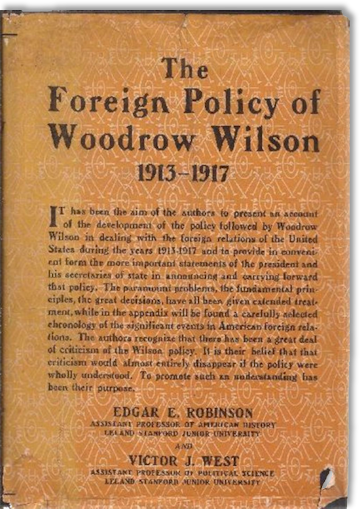
 An image of the Robinson / West book
An image of the Robinson / West book
Foreign Policy of Woodrow Wilson
1913 - 1917
This information is of great interest to us here at the website. Helen was not Woodward's only friend to make a career related to what could be best called "social economics." RSW's close friend Victor West followed a similar path (rose to Head of the Political Science department at Stanford U. The school's first). Social Economics is the study of economic effects on society as the result of great change and growth. Woodward did use the term itself in letters to Helen. This connection gives us a better understanding of Woodward's career as an artist. When seen in this context, RSW's portrait of New England life, particularly the pastoral ruins of abandon farms, decaying barns and plighted homesteads, could very well be his commentary on the greater national issues of the time. More than simply portraits of the simple grace and dignity of its landscape and people, yet that of the changing national landscape with New England not only being greatly effected but having trouble keeping up (see Boston Romance for more). He did tell Helen once, "I usually wish I too might be a 'becoming writer of note' in all earnest. It would be so delightful to have something to say to the world, something of vital life interest, and to be able to say it as one should... But during such wishes I catch myself and say, knowing within me the while, that it's to be quite as beautiful to be an artist , to tell men of godly beauty thru color and form, my religion, especially the former." In the context of his experience, his nomadic childhood, his accident, the first-hand perspective of forces greater than oneself effecting one's circumstances, the perseverance to "go on" would be astutely understood by Woodward but that is an essay for another day and in the works. For the time being, however, it is an added layer of depth to the longevity of Woodward's connection to Helen and for that matter Victor West too.
CLICK HERE for more on RSW friend Victor J. West
( Page will open in a new tab)
Between RSW's letter to Helen from Boston and his leaving school and moving to Buckland the letters become less frequent. As they should, both are well into making their way in their lives. The letters span the rest of his life up to 1953 when RSW's hands began to shake too much to paint, no less write. The letters are not as intimate as his high school years or after his accident but are informative nonetheless. There are the letters regarding the 1938 hurricane that destroyed much of the northeast. He writes her concerned for her well being, however, does not give us any clue as to where she is New Jersey or Rhode Island. What is of particular interest, however, is a letter (undated) he sent her with a clipping of an illumination he recently had published in a unnamed magazine, titled, Night Verses to the Little Shops, and he questions Helen on what subject matter she would like for her bookplate design! Unfortunately, we do not know if he ever made her a bookplate. There are no follow ups to the letter, most likely because habitually RSW burned all his letters.
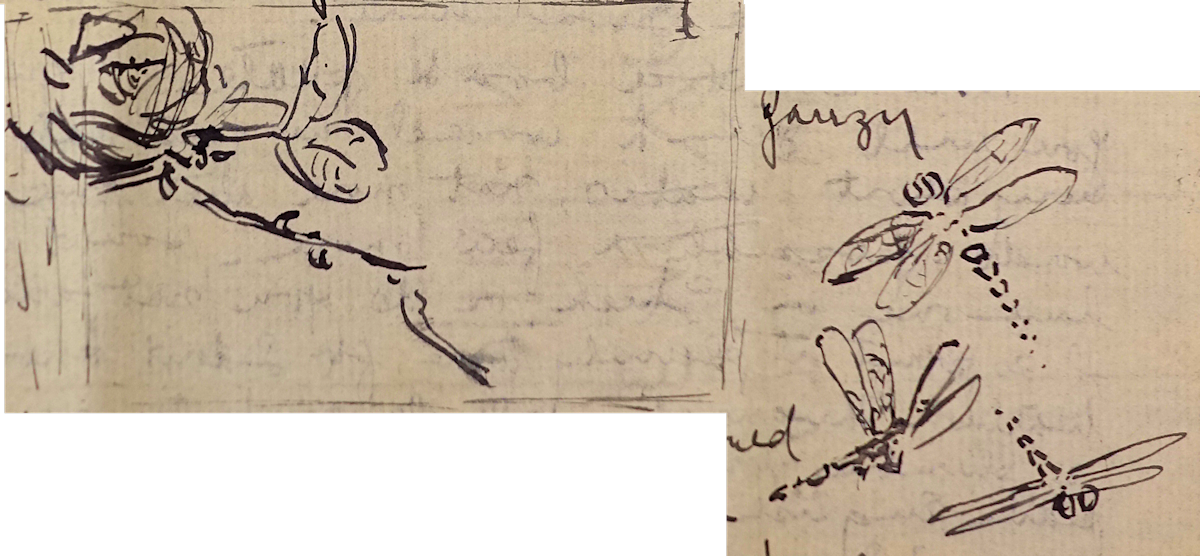
 The doodle of a flower and dragon flies
The doodle of a flower and dragon flies
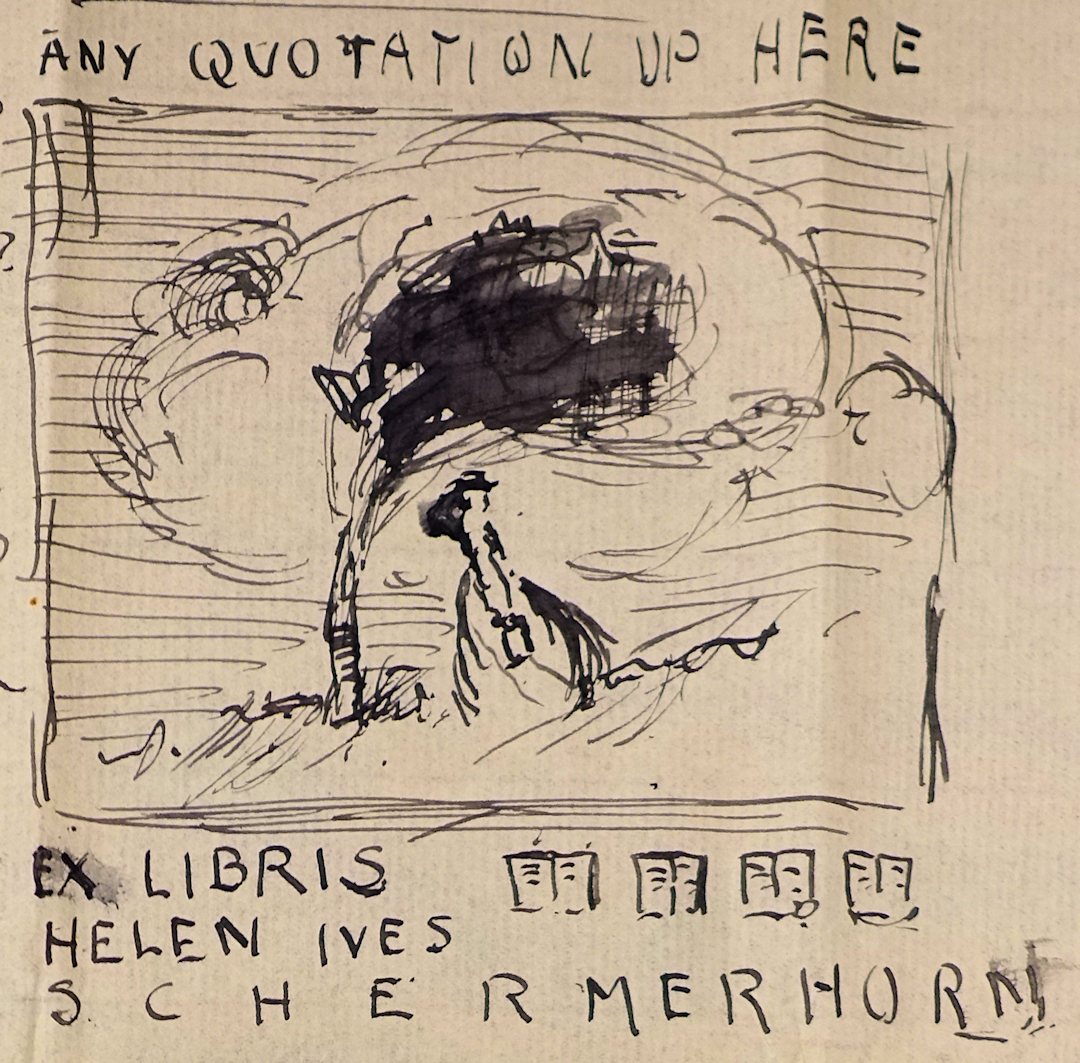
 A sketch of a girl under a windswept tree
A sketch of a girl under a windswept tree
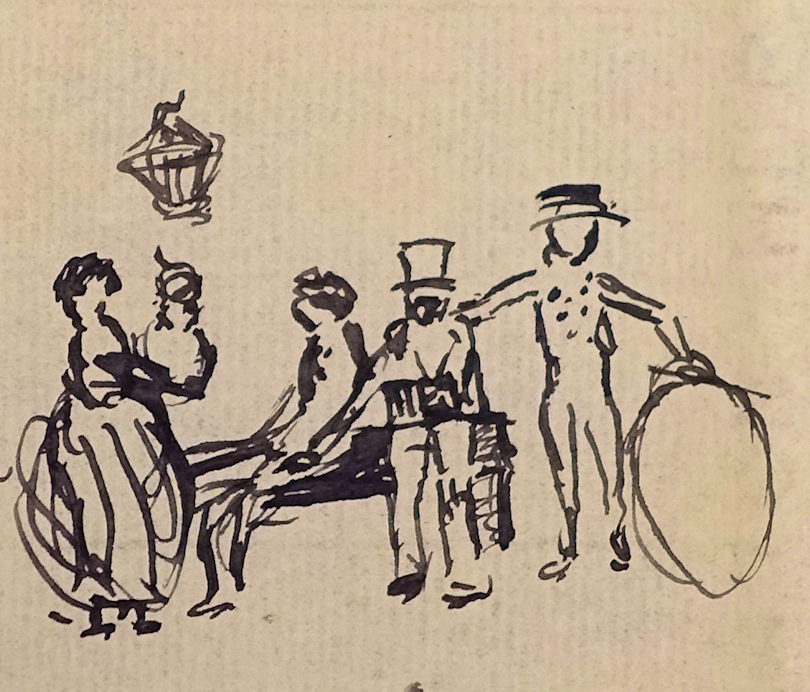
 A sketch of the group of characters
A sketch of the group of characters
decribed by RSW
He writes, "Now about a book plate. A quotation if you will, I think would be first rate, were it very short - that is, not more that [sic] five or six words -
possibly a few more - How'd it be to have one in Greek, or do you not fancy it? If so, print it plainly to me, for I don't know the heathen language. (Or do you prefer one in latin - "e pluribus num, tempus fugit -"? Or just plain
English? [translation- out of many, as to whether, the time that runs away] And do you wish your entire name?" Then he goes on proposing artwork design and doodles them for her, "Now for subject matter - I've in my mind a
number of ideas, but you would tell me what to make. I spoke of a group of little old fashioned children, reading a book to-gether n'est-ce pas?... What I want to get at is - would you care for anything so simple as a mere flower?
How about a rose? And say do you like darning needles? They are "terribly" decorative little creatures [the next sentences surround a sketch of a rose and 3 dragonflies] almost any way you can put them, with their gauzy wings,
their huge eyes, and their segmented bodies - a rose and a darning needle - I'm sure the idea would not be likely to be imitated in another book plate any way. Then how'd you like, perchance a wind blown tree, with a huge
cloud back of it - Helen, who loves the wind and clouds and the out door fields? [the next sentences are to the left of a sketch of a windblown tree with a girl holding a book under it with "Any quotation here" at the top and
"Ex Libris Helen Ives Schermerhorn" at the bottom] and a girl with a wind blown skirt, holding a book and standing under the tree with her hand up to her hat? "Wind blown" skirts are attractive, in their lines.
The group of youngsters I had in mind are grouped like this. [the next sentences are to the left of a sketch of 4 children, one with a hoop, one with a book, one listening , and a girl holding a baby with a bird cage overhead]
One boy with a hoop, one reading, one listening only, and a little old fashioned girl with a baby on her arm and a bird in a rush cage over head. Should the idea at all please you this sketch is enough to "queer" the idea, tho.
If a quotation of several words, or rather a number of words there is a way, much used, tho still good, of making a border of them (the words), with a bit of decoration..."
To think there might be a Schermerhorn
bookplate out there is almost too much to comprehend. We admitted it from the transcript above but RSW briefly goes into his own ideas for his bookplate. You can read it for yourself in the images we provide. We are
pretty certain it was never made or we would surely know of it or have found it in one of the many books he left behind.
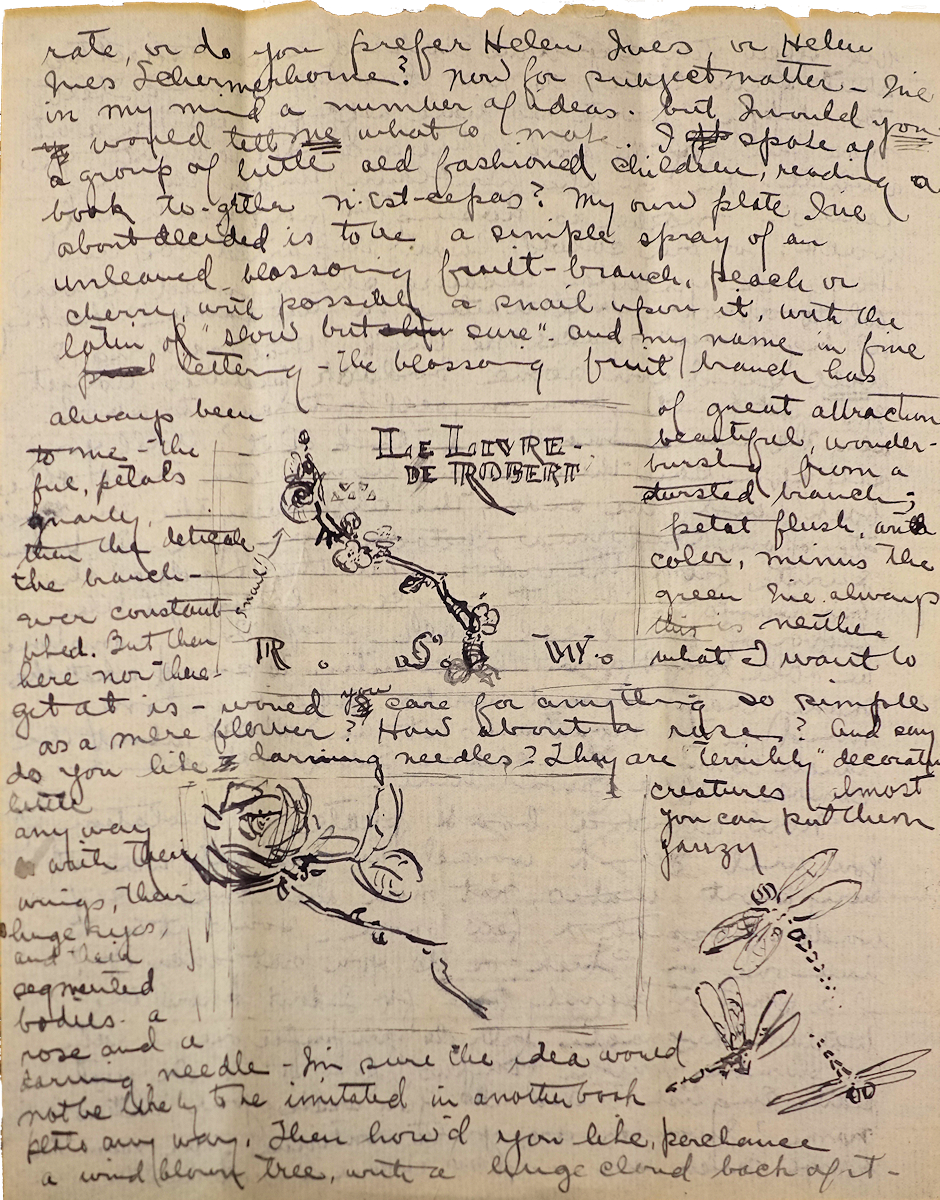
 First Page of the letter RSW ask Helen about a bookplate
First Page of the letter RSW ask Helen about a bookplate
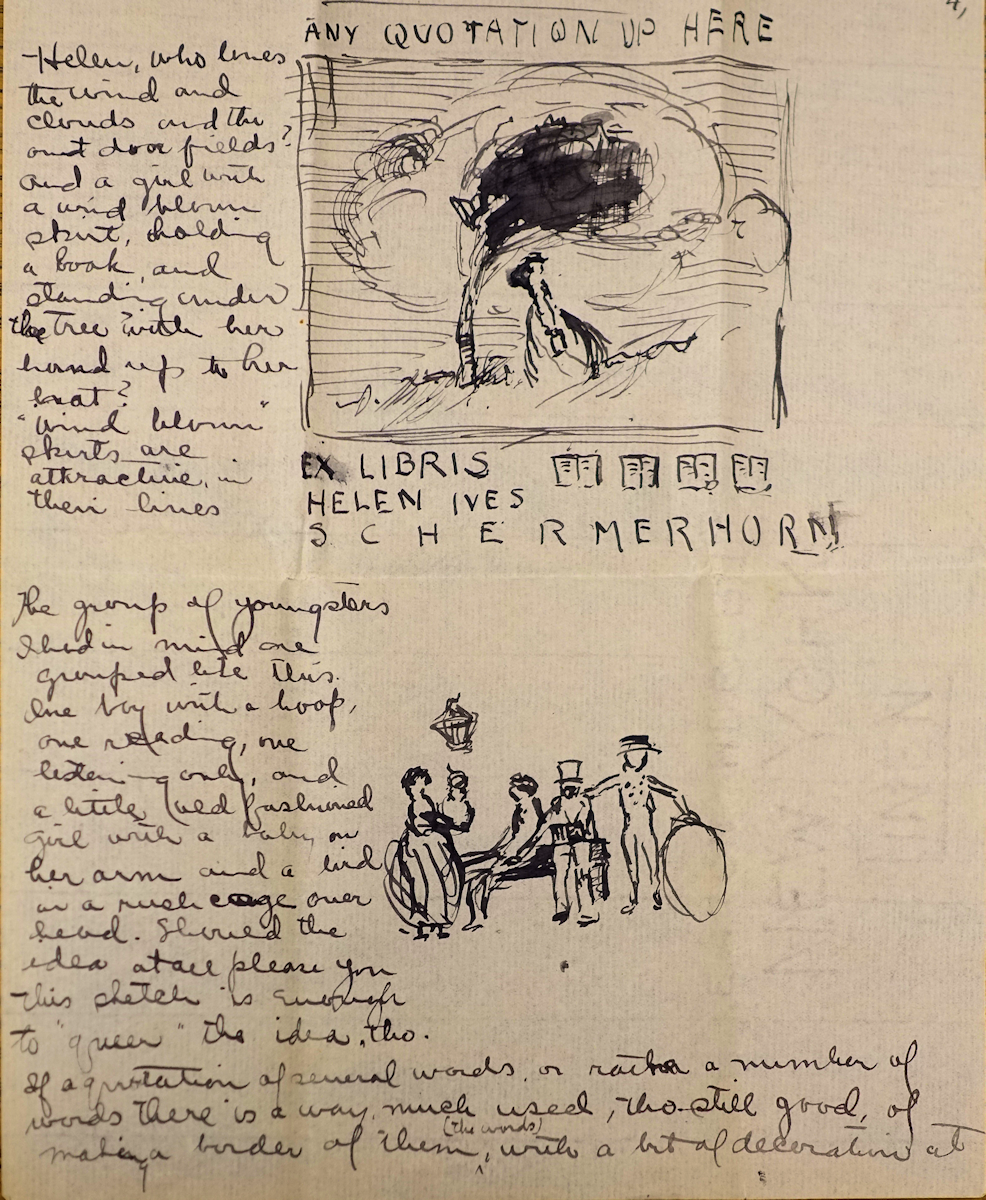
 Second Page of the letter RSW ask Helen about a bookplate
Second Page of the letter RSW ask Helen about a bookplate
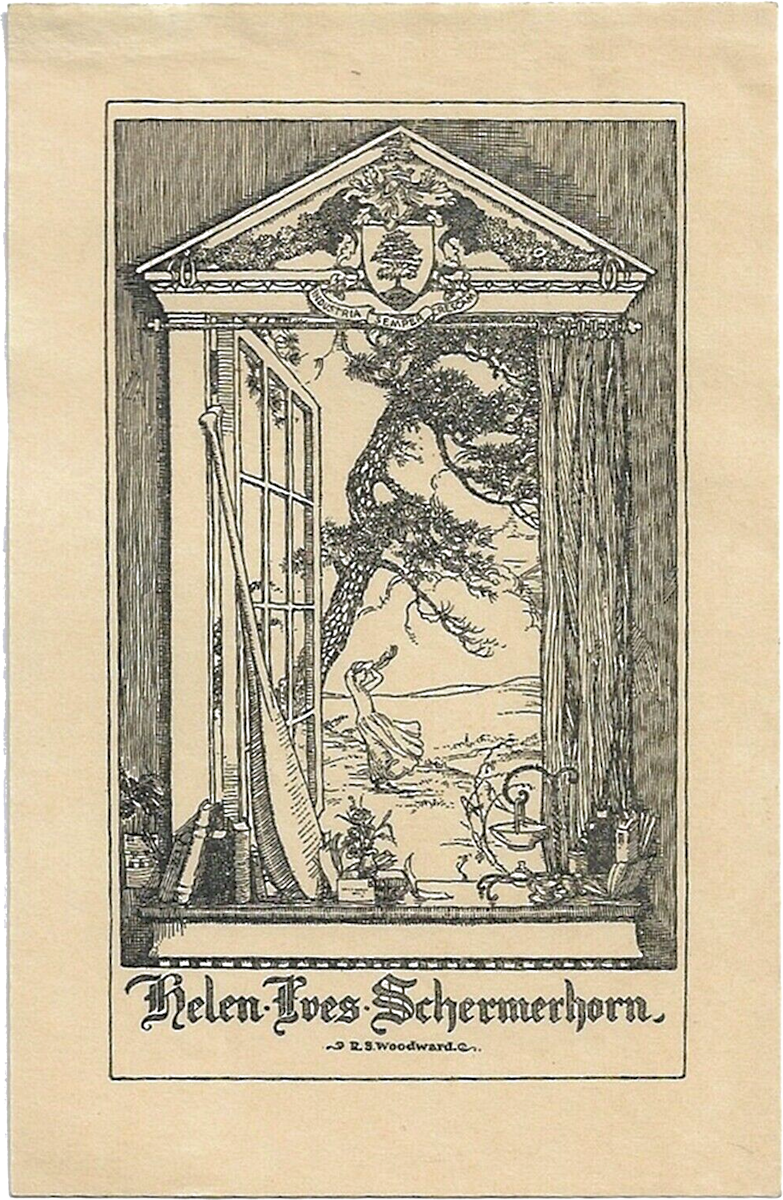

The Helen Ives
Schermerhorn
Bookplate
ADDENDUM TO THIS SECTION:
October 20, 2020: We have recently learned Woodward did indeed design a bookplate for
Helen. We were contacted by a collector who happened upon the bookplate from an art dealer in Europe. The collector, searching for information on Helen, found us and reached out including an image of the bookplate.
What stuck us almost immediately is how much the bookplate design resembles and contains many of the features that would become synonymous with his popular window paintings after 1936 when he moved to Southwick.
Especially the "little East Window" he so frequently painted. The only thing to survive his original suggestions to her was the girl with the wind blowing her hair. Also, instead of "Ex Libris" (meaning, "from the library of...") Helen
went with her family crest and motto, "Industria Semper Creseam."
A number of the items decorating the window are again, common to Woodward's window paintings. There are the books and the potted
plant. The object to the right of the window could be some personal item of Helen's that Woodward included. But note the letter (common in a number of Woodward's window paintings) near what appears to be two canoe
paddles. We believe this is a personal reference on Helen and their relationship. We believe it is possible this was an activity they both mutually enjoyed. For more see...
The Helen Ives Schermerhorn Bookplate Page
Helen lived out the remainder of her life in Rhode Island, near her brother and his wife Anna who experienced numerous health issues throughout her life. There are even several letters from RSW to Anna while she was in the hospital. In the post-1910 letters, RSW often asked her if she would be visiting him on her vacation but again because we do not have her responses. We believe she did from time to time stay with him from the context of his question. We have no record of Helen ever marrying, though RSW does make a brief reference to an engagement by asking her if she will change her name. There are also no records of her ever having children. It could simply be that she was married to her work. She would die on September 20, 1970 at the age of 86 years old. Long retired at the time, her obituary cites her role as Principle of the Providence Night School. It names her brother and sister-in-law as survivors.
